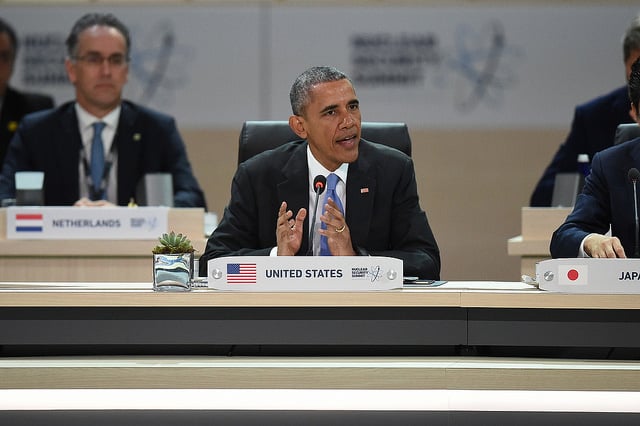
In 2009 the Norwegian Nobel Committee bestowed the Nobel Peace Prize on Barack Obama for, among other reasons, ‘the special importance’ of the US President’s ‘vision of and work for a world without nuclear weapons’. The prize’s recipient had sketched out this vision some months previously in a speech in Prague, which became famous for being the first time since the invention of the atomic bomb that a President and Commander-in-Chief of the most powerful nation on Earth dared to countenance it. One year later he would categorically announce that his country ‘will not develop new nuclear warheads or pursue new military missions or new capabilities’.
The dream was short-lived. In the home straight of his second term, his Administration has embarked on an intensive and costly modernisation programme (‘modernising through reduction’, according to the Department of Energy, which is in charge of these warheads), representing a significant blemish on an otherwise relatively blemish-free record. It is not only the US that has chosen this path: Putin’s Russia and Xi Jinping’s China have also embarked on renewal programmes for their respective nuclear arsenals, the behaviour of one serving as an excuse for the others. We may be in the presence of a new nuclear arms race, although very different from the era of Mutually Assured Destruction, which provided the basis for the balance of terror and dissuasion that operated between the US and the then Soviet Union. It was a pas de deux, and this era has ended, however much some insist that the Cold War has made a comeback –but don’t throw away your old books about nuclear dissuasion, such as Herman Kahn’s Thinking about the Unthinkable (1962)–. This time there are more players, with far fewer nuclear weapons –although enough to destroy the Earth several times over– and no confrontation of economic and socio-political systems. The danger is that this new race involves nuclear bombs that are smaller, more precise and faster –“hypersonic”–, increasing the temptation to use them.
The National Nuclear Security Administration’s plan revolves around the so-called ‘3 + 2’ consolidation strategy. The arsenal of the future will consist of three warheads deployed by the US Air Force and long-range missiles deployed by the navy, plus two types of air-launched nuclear arms deployed in cruise and air-dropped missiles.
The Obama Administration essentially blames Russia for not having taken advantage of the new 2010 START agreement (which the US honours, although it has never been ratified by the Senate) to significantly reduce its nuclear arsenal. The target is for each to have 1,550 warheads –an excessive number, although this has not prevented Donald Trump from rejecting such a cut out of hand– when their combined stockpiles number more than 15,000, including those that have not yet been decommissioned. Russia has embarked on manufacturing larger missiles with multiple miniaturised warheads, and even, according to some reports, underwater drones that launch radioactive contamination against cities. China, while adhering to its doctrine of never being ‘the first to use’ nuclear weapons, could have its new DZ-ZF hypersonic bombs –‘hypersonic glide vehicles’– ready by 2020. Launched by missile, this type of warhead detaches and flies extremely fast, constantly changing its trajectory so as to thwart defensive measures arrayed against it. China is also renovating its long-range rockets. But with slightly more than 200 warheads (240 according to most sources, although it could be more), China trails well behind the Russians and Americans in this field.
The US is also developing hypersonic bombs (although the first test in 2014 was a failure); and in principle they are not expected to carry nuclear but rather conventional payloads, although thanks to their precision and speed they could destroy enemy silos. The nuclear modernisation programme launched by Obama could cost as much as US$3 trillion over 30 years. The test conducted in Nevada last year involving a new model of B61-12 mini-nuclear warhead, without a payload, was described by Moscow as ‘irresponsible’ and ‘provocative’.
What it all amounts to is a move towards new types of small, undetectable and precise systems. The Union of Concerned Scientists, which includes some former experts and advisers to the Obama Administration on security matters, has been criticising these developments in various reports since 2013. Even General James E. Cartwright, now retired but formerly the vice chair of the Joint Chiefs of Staff under Obama and before that commander of the US Strategic Command (which controls aircraft and missiles with nuclear payloads), has publicly warned that moving to smaller and more precise nuclear weapons makes them ‘more thinkable’, in other words, increases the likelihood of their being used.
In the recent Nuclear Security Summit in Washington, Obama himself acknowledged the need to guard against ‘ramping up new and more deadly and more effective systems that end up leading to a whole new escalation of the arms race’. He is, in other words, a long way from his original intentions in this regard. And the blame cannot be attached to the volatile and dangerous North Korea; or Tehran, when Obama’s diplomacy achieved the significant feat of convincing the Iranians to forswear, for 10 years at least, the development of a nuclear weapons programme.
Curiously, none of this seems to form part of the relatively reasonable ‘Obama doctrine’ that the President set out in his recent interview in The Atlantic.


